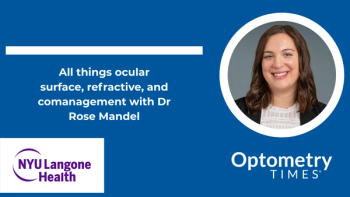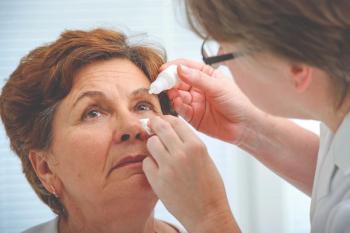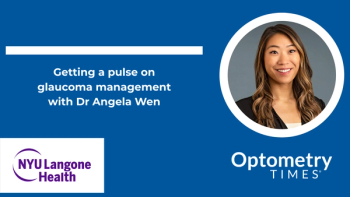
Daily disposables-a great option
Daily disposable contact lenses provide a clean, deposit-free, sterile lens in a saline-based solution on a daily basis, so that each new lens is comfortable, safe, and convenient.
We are very fortunate to be practicing in a time when there are many options available for contact lens-wearing patients. This is especially true in the area of daily disposable contact lenses (DDCLs). The idea of a DDCL was first suggested in 1972 soon after the introduction of soft contact lenses.1 While the first true DDCL didn't come along until a quarter century after that idea, the modality offers many advantages to our patients.
Dr. BowlingThe concept behind DDCLs is to provide a clean, deposit-free, sterile lens in a saline-based solution on a daily basis so that each new lens is comfortable, safe, and convenient.2 This modality resolves most of the problems encountered with the use of conventional soft contact lenses.
Conventional soft lenses build up deposits, which are difficult to remove, and conventional lenses need daily cleaning and disinfection. Yet compliance with cleaning regimens is a real concern with many patients. DDCLs offer a convenient choice for patients who wish to avoid daily lens care and other concerns associated with conventional soft contact lens wear.3
Comfort and convenience
Convenience is important to our patients, but it’s not as important as good vision. In a survey of 3,800 patients from seven countries wearing vision correction, vision was the most important factor when choosing eye-related products.4
In this study, subjects were twice as concerned about vision quality than they were about comfort or convenience. Patients wearing disposable soft contact lenses performed significantly better than patients wearing conventional lenses, in terms of Snellen visual acuity, and have better subjective vision.5 They were also less likely to return for an unscheduled visit to their eyecare provider then subjects wearing conventional soft lenses.5,6
Comfort is often cited as a major reason that patients discontinue contact lens wear. Surveys have shown that from 25%4 to 51%7 of patients give discomfort as the reason for giving up on contact lens wear. In a comparison study of conventional and daily disposable soft contact lens users, it was reported that daily disposable subjects experienced better comfort.5 The use of disposable contact lenses has been shown to be associated with enhanced comfort.8
DDCLs serve many needs
DDCLs are a better option for patients who suffer with allergies because wearers are not exposed to solutions and cleaners to which they may be sensitive.9 The use of DDCLs eliminates the need for lens care solutions. In a bilateral crossover study of allergy sufferers, 67% of subjects reported that daily disposables provided improved comfort compared to the previous conventional reusable lenses.10
DDCLs can benefit the occasional contact lens wearer, who does not then have to worry about cleaning and storing the lenses between each use. They also are a great option for people who travel frequently, such as frequent fliers, by eliminating the need for transporting contact lens solutions.
Another good use for daily disposable lenses is by patients, especially teenagers, who are not compliant with contact lens care and hygiene. DDCLs are a great alternative for children.
A 2011 study by Efron showed that children are now prescribed the highest proportion of DDCLs.11 Patients who are very active or athletes are good candidates for this modality, as are patients who have a job that carries a high risk of infection, such as hospital staff.12
DDCLs are an option for patients who have experienced problems with other contact lens types in the past. They also are a great choice for patients who struggle with staying on a replacement schedule with conventional 2-week and monthly lenses. Most patients (52%) wearing conventional 2-week and 1-month contact lenses said not remembering when they needed to replace their lenses was their main reason for noncompliance.13 (See Table 1)
What about the risk of infection with DDCLs? While the risk of infection with DDCLs is similar to that of other daily-wear soft contact lenses, the severity of infection is lower.14 So even though a DDCL wearer has the same risk of infection as other soft lens users, Eric Papas, PhD, said, “They can expect to undergo a milder level of disease and have fewer subsequent visual consequences if they are unlucky enough to be so affected.”15
Developments in DDCLs have expanded to include toric lenses for astigmatism, multifocal lenses for presbyopia, and cosmetic lenses. Currently, there are 18 different daily disposable soft lens types available on the market.2 (See Table 2)
If there is a drawback, it is the perception of high cost. Informing the patient of the savings potential when contact lens solutions aren’t needed, and manufacturer rebates available on these lenses, can help to alleviate that perception. One estimate places the cost difference of daily disposables vs. 2-week or monthly contact lenses at as little as $0.30 a day.16
Daily disposable soft lenses are gaining in popularity. A 2012 survey of eyecare practitioners from 36 countries, including the United States, showed that DDCLs were fitted for 33% of patients.17
A range of patient symptoms can be reduced and clinical signs can be improved with DDCLs. Their convenience, comfort, and reduced health risks are benefits that make this modality an attractive option to our patients.ODT
References
1. Agarwal RK. Some thoughts on soft lenses. The Contact Lens. 1972 4(1):28.
2. Cho P, Boost MV. Daily disposable lenses: The better alternative. Contact Lens Ant Eye 2013 36(1):4-12.
3. Nilsson SEG. Ten years of disposable contact lenses – a review of benefits and risks. Contact Lens Ant Eye 1997 20(4):119-128.
4. Saks A, Mack CJ, Rah MJ. Deriving site and insight from the NSIGHT study: the vision. Rev Optom 2011 148 (6 Suppl):8-11.
5. Nason RJ, Boshnick EL, Cannon WM, et al. Multisite comparison of contact lens modalities. Daily disposable wear versus conventional daily wear in successful contact lens wearers. J Am Optom Assoc 1994 65(11):774-780.
6. Nichols JJ, Mitchell GL. Zadnik K. Daily disposable versus disposable extended wear: A contact lens clinical trial. Optom Vis Sci 2000 77(12):637-647.
7. Young G, Veys J, Pritchard N, et al. A multi-centre study of lapsed contact lens wearers. Ophthalmic Physiol Opt 2002 Nov; 22(6): 516-527.
8. Walker J, Young G, Hunt C, et al. Multicenter evaluation of two daily disposable contact lenses. Contact Lens & Anterior Eye 2007;30(2):125-133.
9. Lemp MA. Contact lenses and allergy. Curr Opin Allergy Clin Immunol 2008 8(5):457-460.
10. Hayes VY, Schnider CM, Veys L. An evaluation of one day disposable contact lens wear in a population of allergy sufferers. Contact Lens Ant Eye 2003 26(2):85-93.
11. Efron N, Morgan PB, Woods CA. International Contact Lens Prescribing Survey Consortium: Survey of contact lens prescribing to infants, children, and teenagers. Optom Vis Sci 2011; 88:461-468.
12. Hay J, Seal DV. Contact lens wear by hospital health care staff: is there cause for concern? J Hosp Infect. 1995 Jun;30 Suppl:275-81.
13. Dumbleton K, Richter D, Woods C, et al. Compliance with contact lens replacement in Canada and the United States. Optom Vis Sci 2010; 87(2):131-139.
14. Stapleton F, Carnt N. Contact lens-related microbial keratitis: how have epidemiology and genetics helped us with pathogenesis and prophylaxis. Eye (Lond) 2012 26(2):185-193.
15. Papas E. Daily disposable contact lenses: the king in waiting? CL Spectrum 2013 28(1):14-15.
16. Nixon G. Contact lens practice pearls: You can increase usage of daily disposables. CL Spectrum 2012 27(2):48.
17. Morgan P, Woods C, Tranoudis IG, et al. International contact lens prescribing in 2012. CL Spectrum 2013; 28(1):31-38.
CAPTIONS:
Table 1. Percentage of contact lens wearers who always follow their recommended lens replacement schedule.
Table 2. Daily disposables in the U.S. market.
Newsletter
Want more insights like this? Subscribe to Optometry Times and get clinical pearls and practice tips delivered straight to your inbox.




















































.png)


